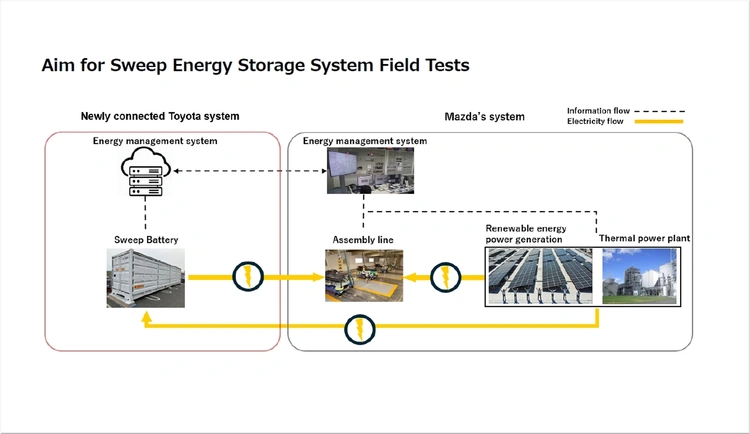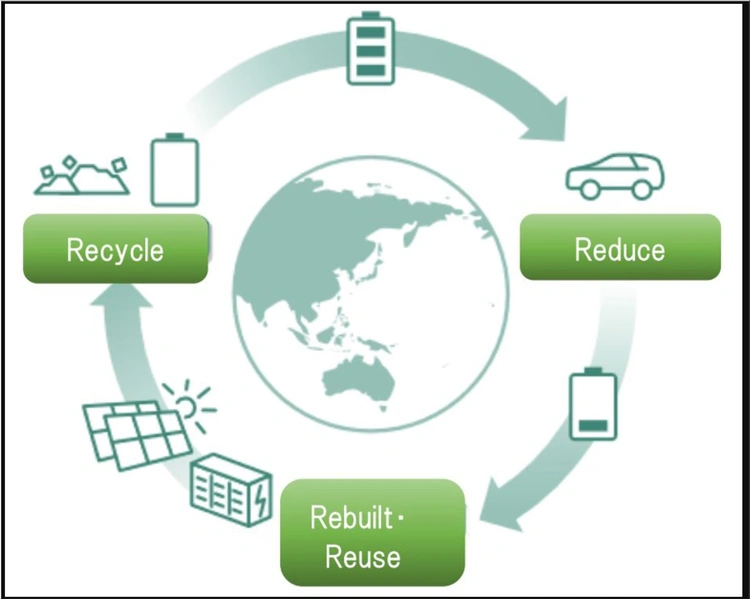Building a Battery Ecosystem
Toyota and Mazda have begun field tests of an energy storage system that uses batteries from electrified vehicles. The trials take place at Mazda’s Hiroshima headquarters. It is the only automaker-run power generation site in Japan.
The goal: prove that car batteries can serve as stable, high-quality power sources when linked to large-scale grids. The companies call the setup the Sweep Energy Storage System, developed by Toyota.
This approach could change how automakers manage renewable energy, battery recycling, and supply chains.
How the Sweep Energy Storage System Works
The Sweep system connects Mazda’s local power generation network with Toyota’s battery-based storage platform. Together, they test charging and discharging at scale.
The system manages different battery states, from new packs to degraded ones. It rapidly switches each pack on or off, balancing supply and demand. This makes it possible to combine batteries of different ages and capacities without wasting energy.
Key benefits:
- Extends the useful life of EV batteries.
- Supports power demand during peak hours.
- Provides backup energy during outages.
- Smooths out renewable energy supply variations.
Why Toyota and Mazda Are Doing This
Japan’s auto industry faces seven shared challenges, identified by the Japan Automobile Manufacturers Association. One of them is creating a battery ecosystem.
That ecosystem includes:
- Stable procurement of critical minerals.
- Building a resilient supply chain.
- Reusing batteries across industries.
By running these tests, Toyota and Mazda are addressing two problems at once:
- How to reuse electrified vehicle batteries.
- How to stabilize renewable energy output, which fluctuates depending on weather and time of day.
Impact on the Auto Industry
The move signals a shift in how automakers view their products. Cars are no longer just vehicles. Their batteries can double as energy infrastructure assets.
This will influence:
- Electric vehicle costs: Lower lifecycle costs if used batteries serve other purposes.
- Consumer confidence: Knowing EV batteries have a second life may reduce concerns about replacement costs.
- Grid resilience: Automakers may play a bigger role in national energy security.
Toyota’s Strategy
Toyota has often promoted a multi-pathway approach. Instead of betting on one technology, the company works on hybrids, plug-in hybrids, EVs, and hydrogen.
By investing in storage, Toyota strengthens that approach. It connects the auto business to the energy market. That could provide:
- Revenue from grid services.
- Reduced dependency on external suppliers.
- Competitive edge in sustainability metrics.
Mazda’s Role
Mazda contributes by offering its Hiroshima campus power grid. It is the only automaker in Japan running its own electricity generation. This makes it the perfect test site.
The tests will:
- Measure how well the Sweep system integrates with independent grids.
- Show if batteries can stabilize industrial power use.
- Provide insights into scaling the system to other plants.
The Global Context
Battery recycling and reuse are top concerns in Europe, North America, and China. Governments push automakers to reduce waste and source fewer raw materials.
The Toyota-Mazda project aligns with these pressures. It offers a way to reduce raw mineral demand, especially for lithium, cobalt, and nickel.
Other automakers are also moving:
- Volkswagen is developing closed-loop recycling plants.
- GM is working with utilities to use EVs for grid storage.
- Hyundai has pilot projects reusing EV batteries in buildings.
This makes Toyota and Mazda’s cooperation more than a local test. It is part of a global shift.
Challenges Ahead
Reusing EV batteries at scale will face several hurdles:
- Safety: Degraded batteries pose fire risks if not managed properly.
- Standardization: Automakers use different pack designs, making reuse harder.
- Economics: Second-life batteries must compete with new storage technologies.
- Policy: Regulations differ widely across markets.
The Sweep system addresses some of these issues. Its switching mechanism allows mixed-capacity batteries to work together. That could make scaling more practical.
What This Means for Consumers
For drivers, the immediate impact is small. But long term, this effort could:
- Lower EV battery replacement costs.
- Improve resale value of used EVs.
- Reduce strain on electricity grids, making renewable power more reliable.
Consumers may also benefit indirectly if automakers sell energy services and pass on the savings.
The Business Case
Both companies stand to gain:
| Benefit | Toyota | Mazda |
|---|---|---|
| Technology leadership | Yes | Shared via grid test site |
| Energy cost savings | Yes | Yes |
| New revenue opportunities | Grid services | Industrial power management |
| Sustainability metrics | Stronger ESG performance | Improved plant efficiency |
This makes the project more than a technical test. It could reshape how automakers position themselves in the energy market.
The Road Ahead
Toyota and Mazda have confirmed that these are field tests, not commercial rollouts yet. But the direction is clear.
- EV batteries will serve a second life.
- Automakers will integrate with energy systems.
- The industry will compete not just on vehicles, but on energy infrastructure solutions.
Conclusion
Toyota and Mazda’s tests may look small today. But they hint at a larger shift: the battery ecosystem as the new front line of competition.
If the Sweep Energy Storage System works as planned, EV batteries could outlast the vehicles they power. They would become key to stabilizing grids, supporting renewables, and reducing mineral demand.
For automakers, that means higher resilience and new revenue streams. For consumers, it means lower costs and stronger confidence in EVs.
The project is not about one company winning. It is about keeping Japan’s auto industry competitive while aligning with global pressures on sustainability and resource use.
Volkswagen has announced its ambitious plan to make electric cars affordable and accessible for everyone. The Volkswagen company, which has been at the forefront of the global electric mobility revolution, has promised to launch its first "e-… Continue reading
The MG4 electric hatchback has been one of the most popular and affordable EVs in Europe since its launch in 2023. The car has won several awards for its design, performance, and technology and has attracted many customers who are looking for a practical and… Continue reading
Honda unveiled two new electric vehicle (EV) ideas at the CES 2024 in Las Vegas, Nevada, as part of its new global Honda 0 Series, which will be available in 2026. The two concepts, Honda Saloon, and … Continue reading
The lithium-ion battery has been the dominant force in portable electronics for decades, but its reign might be nearing its end. Enter solid-state batteries, a new technology with the potential to revolutionize the way we power our devices, from smartphones… Continue reading











